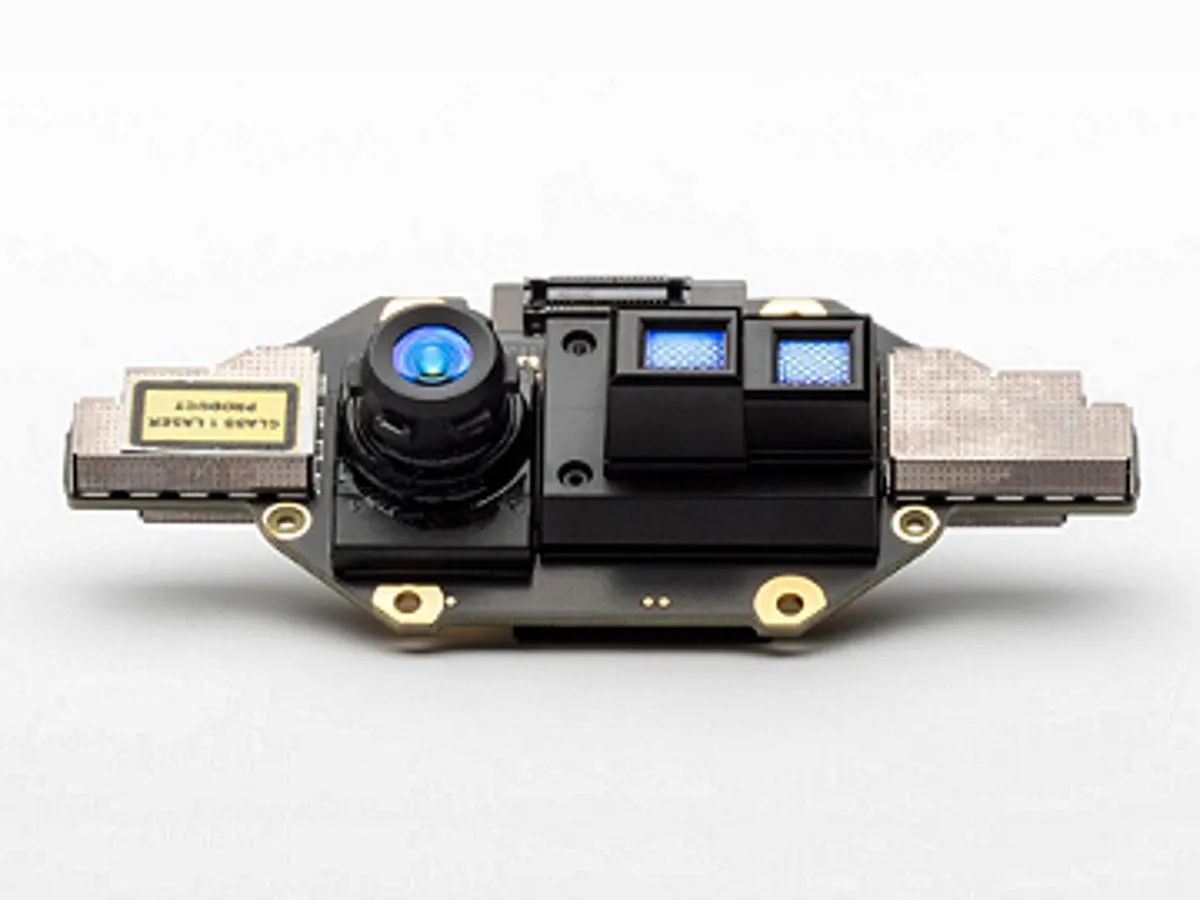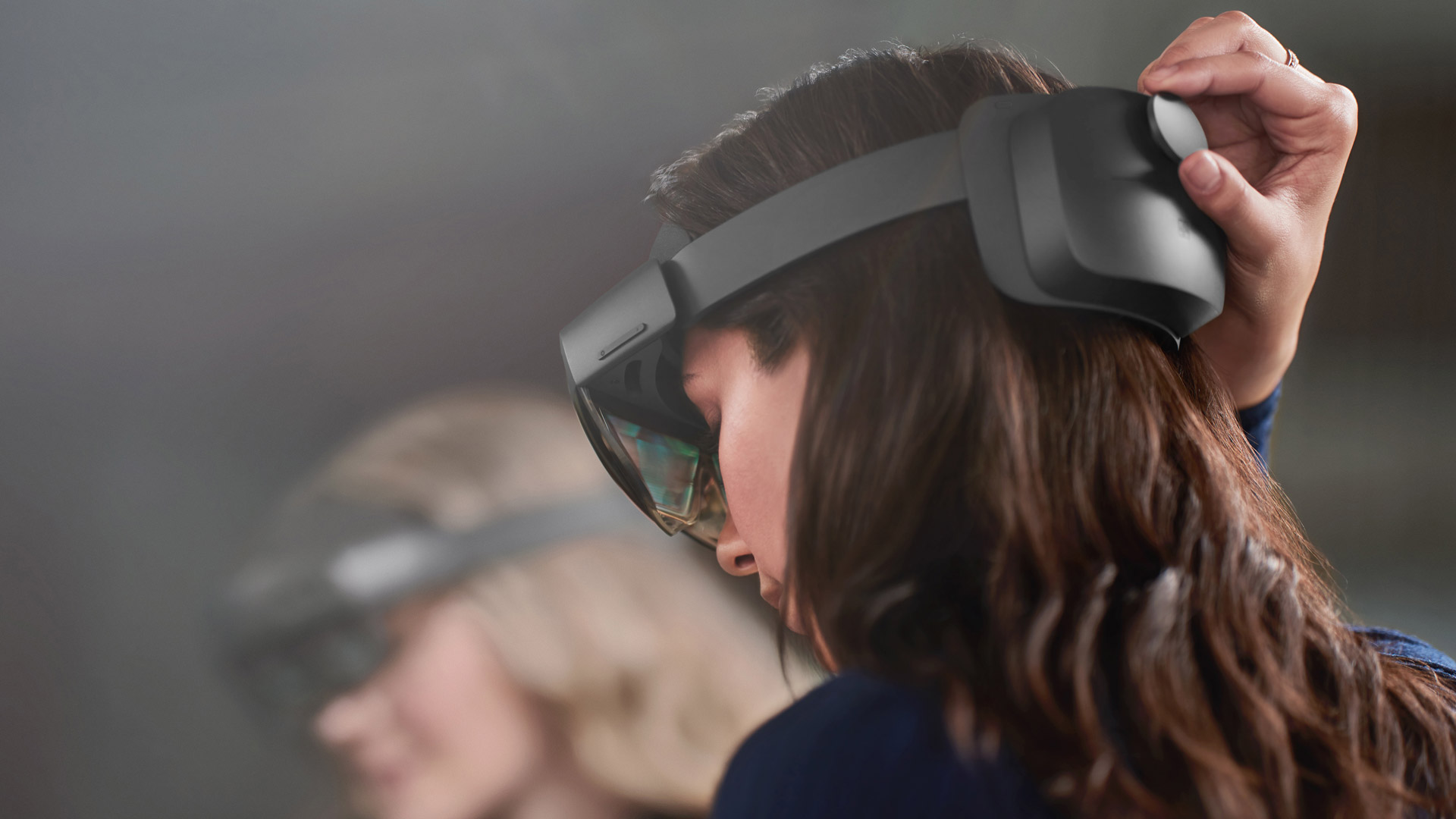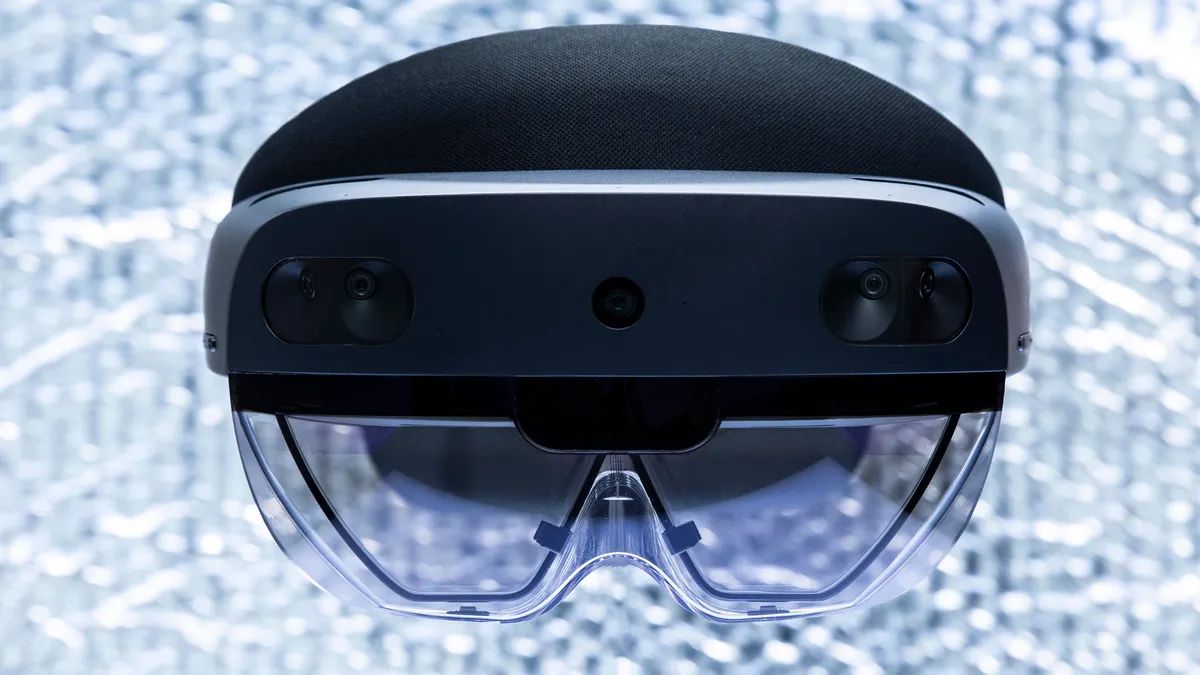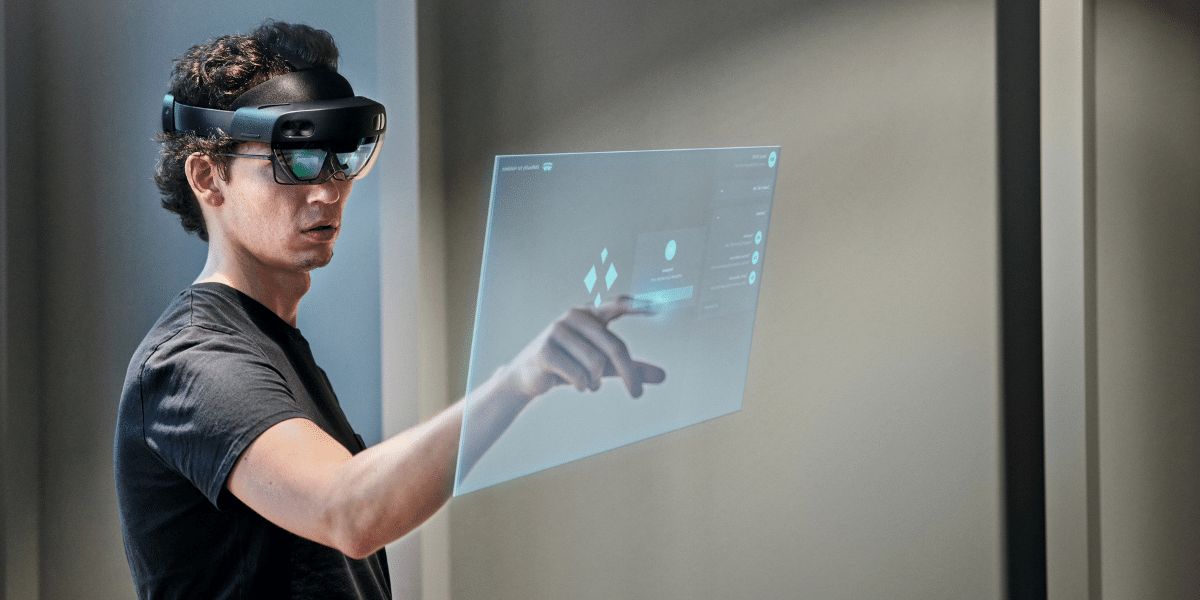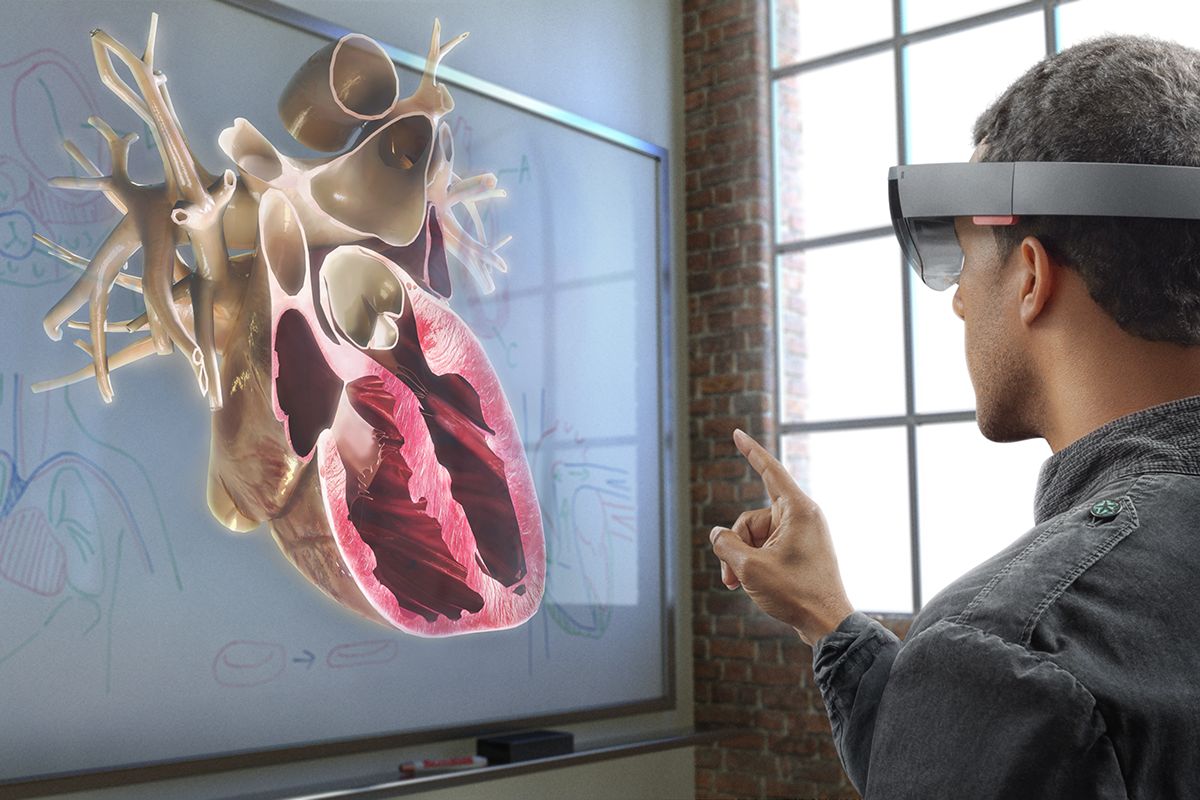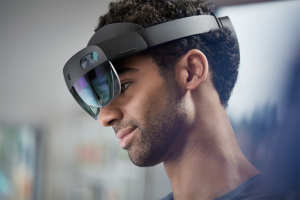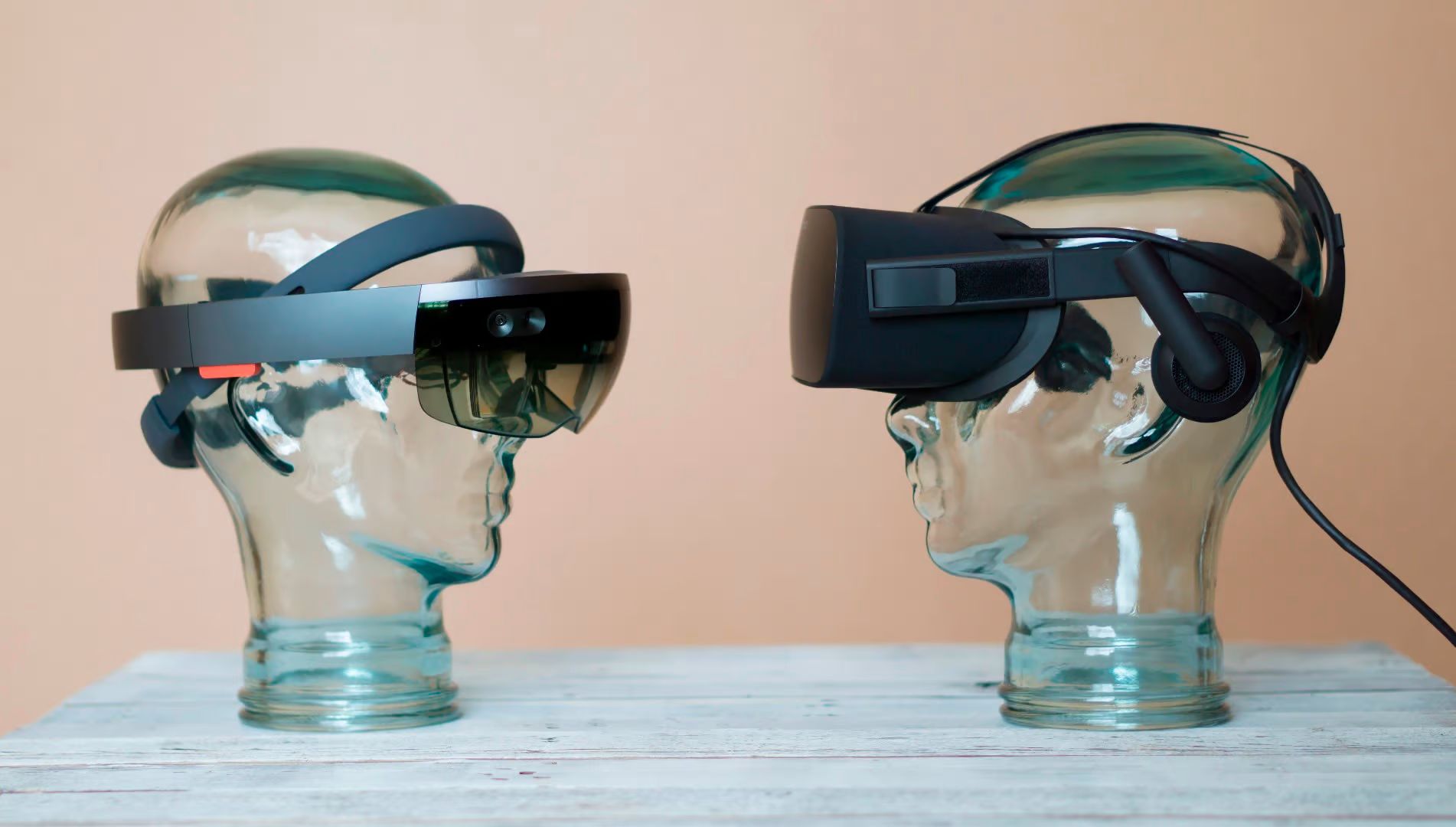Introduction
Welcome to the exciting world of HoloLens and its fascinating eye tracking technology. HoloLens is a mixed reality headset developed by Microsoft, revolutionizing the way we perceive and interact with digital content. It brings the virtual and real worlds together, allowing users to seamlessly blend their physical surroundings with immersive holographic experiences.
Eye tracking, as the name suggests, is the technology that enables HoloLens to track users’ eye movements and gather valuable data about their gaze points and focus. This sophisticated feature plays a vital role in enhancing the user experience by intuitively understanding users’ intentions and adjusting holographic content accordingly.
HoloLens eye tracking opens up endless possibilities for developers, researchers, and users alike. It enables natural interaction, precise targeting, and dynamic content manipulation, taking the mixed reality experience to new heights.
In this article, we will dive deep into the world of HoloLens eye tracking, exploring the technology behind it, its components, the role of infrared light, the measurement of eye movements, the calibration process, its accuracy, limitations, and future developments.
Let’s embark on this exciting journey to unravel the inner workings of HoloLens eye tracking and discover how it contributes to an immersive mixed reality experience.
What is Eye Tracking?
Eye tracking is a technology that enables the measurement and analysis of eye movements. It is accomplished through the use of specialized hardware and software that accurately track the position and gaze direction of a person’s eyes. This technology has applications in various fields, including psychology, market research, usability testing, and now, mixed reality headsets like HoloLens.
The human eye is a remarkable organ that allows us to see the world around us. Eye movements, such as saccades (rapid movements between fixation points), smooth pursuits (tracking moving objects), and fixations (pausing to gather visual information), are integral parts of our visual perception process. Eye tracking technology precisely captures and analyzes these movements, providing valuable insights into human behavior and cognition.
In HoloLens, eye tracking takes on a whole new meaning. It allows the device to understand where the user is looking, enabling seamless interaction and manipulation of holographic content. This creates a more natural and intuitive user experience, as users can simply glance at objects or UI elements to interact with them, eliminating the need for traditional input methods like controllers or gestures.
Eye tracking in HoloLens goes beyond just gaze tracking. It also provides information about pupil size, blink detection, and even eye position in 3D space. This rich data opens up possibilities for advanced applications like eye-controlled interfaces, adaptive content rendering based on eye focus, and even gaze-based authentication systems.
By incorporating eye tracking technology into HoloLens, Microsoft has transformed the way we interact with mixed reality environments. It has brought us one step closer to seamlessly merging the physical and digital worlds, creating a truly immersive and responsive mixed reality experience.
The Importance of Eye Tracking in HoloLens
Eye tracking technology plays a crucial role in HoloLens, as it enhances the overall user experience, improves interaction, and enables more intuitive control over holographic content. Here are some key reasons why eye tracking is important in HoloLens:
1. Natural Interaction: Eye tracking allows users to interact with holographic content in a more natural and intuitive way. By simply looking at objects or UI elements, users can trigger actions, select options, or navigate through menus. This creates a seamless and hands-free interaction, making HoloLens accessible to a wider audience.
2. Precise Targeting: With eye tracking, HoloLens can precisely determine what the user is looking at. This enables accurate targeting of objects or specific points in the environment, allowing for precise interactions. For example, users can effortlessly highlight and manipulate holograms by simply gazing at them, enhancing precision and control.
3. Dynamic Content Manipulation: Eye tracking enables dynamic content manipulation based on user focus. HoloLens can detect where the user is looking and adjust the holographic content accordingly. This means that holograms can resize, reposition, or respond to the user’s gaze, creating a more immersive and personalized experience.
4. Adaptive User Interfaces: Eye tracking data can be used to adapt user interfaces in real-time. HoloLens can analyze the user’s gaze patterns and optimize the placement and visibility of UI elements based on their individual viewing habits. This results in more comfortable and efficient interactions, reducing the cognitive load on the user.
5. Data Analytics and User Insights: Eye tracking in HoloLens provides valuable data for developers and researchers. It allows them to analyze gaze patterns, understand user behavior, and gather insights into how users interact with holographic content. This information can be used to improve user interfaces, design more effective experiences, and tailor applications to specific user needs.
HoloLens eye tracking technology is a game-changer in the world of mixed reality. It brings us closer to a future where interacting with digital content seamlessly integrates with our natural behaviors and perceptions. With eye tracking technology, HoloLens is pushing the boundaries of what is possible, creating a more immersive and engaging mixed reality experience.
Technical Overview of HoloLens Eye Tracking System
The eye tracking system in HoloLens consists of a combination of hardware and software components that work together to accurately track the user’s eye movements. Let’s take a closer look at the key technical aspects of HoloLens eye tracking:
1. Eye Tracking Sensors: HoloLens is equipped with multiple sensors that capture eye movement data. These sensors include high-resolution cameras and infrared cameras that track the position and gaze direction of the user’s eyes. The infrared cameras are especially important, as they can detect the infrared light emitted by the eyes, even in different lighting conditions.
2. Infrared Illumination: To enhance the accuracy of eye tracking, HoloLens uses infrared light to illuminate the user’s eyes. This allows the infrared cameras to capture the reflection of the infrared light, providing a clear and distinct image of the eyes. The use of infrared light enables reliable eye tracking even in various lighting environments.
3. Eye Models: HoloLens utilizes sophisticated algorithms and models to interpret the eye movement data captured by the sensors. These models take into account various factors, such as the curvature of the cornea, the lens characteristics, and the position of the pupil, to accurately estimate the user’s gaze direction and focus point. The eye models are continuously updated and refined to improve the accuracy and precision of eye tracking.
4. Calibration Process: Before using the eye tracking feature, HoloLens requires a calibration process. During calibration, the user follows a set of prompts displayed in the headset, which involves looking at specific points on the screen. This process allows HoloLens to align the eye tracking system with the user’s unique eye characteristics, improving the accuracy of eye tracking for that individual.
5. Gaze Tracking and Analysis: Once the eye tracking system is calibrated, HoloLens continuously monitors and analyzes the user’s gaze direction and focus points. It tracks various eye movements, including fixations and saccades, to gather insights into the user’s intent and interactions. This information is then used to adjust holographic content, trigger actions, or provide contextual information based on the user’s eye movements.
6. Data Processing and Integration: Eye tracking data captured by HoloLens is processed in real-time using powerful onboard processors. The processed data is then integrated with the device’s operating system and applications, allowing developers to create immersive experiences that leverage and respond to the user’s eye movements.
The technical components of HoloLens eye tracking work in harmony to provide a robust and accurate eye tracking system. By combining state-of-the-art sensors, sophisticated algorithms, and calibrated eye models, HoloLens enables precise and intuitive interactions with mixed reality content, enhancing the overall user experience.
Key Components of HoloLens Eye Tracking
HoloLens eye tracking system consists of several key components that work together to accurately track the user’s eye movements. These components play a crucial role in gathering and interpreting eye tracking data. Let’s explore the key components of HoloLens eye tracking:
1. High-Resolution Cameras: HoloLens is equipped with high-resolution cameras that capture detailed images of the user’s eyes. These cameras enable precise tracking of eye movements by capturing the reflection of infrared light emitted by the eyes. The high-resolution cameras ensure that even subtle eye movements and changes in gaze direction are captured accurately.
2. Infrared Cameras: Infrared cameras are an essential component of HoloLens eye tracking system. They detect the infrared light emitted by the eyes and capture the reflections to create a clear and distinct image. The use of infrared light ensures that eye tracking works reliably in different lighting conditions, and the eye movements can be accurately tracked.
3. Infrared Illuminators: HoloLens employs infrared illuminators to project infrared light onto the user’s eyes. These illuminators enhance the visibility of the eyes for the infrared cameras, ensuring accurate detection of eye movements. They also compensate for different lighting conditions, allowing for consistent eye tracking performance in various environments.
4. Eye Models: HoloLens utilizes sophisticated eye models to interpret the eye movement data captured by the cameras. These models take into account the unique characteristics of each user’s eyes, such as the curvature of the cornea and the position of the pupil. By accurately modeling the eye, HoloLens can estimate the gaze direction and focus point with high precision.
5. Onboard Processors: The eye tracking data is processed onboard the HoloLens device using powerful processors. These processors analyze the eye tracking data in real-time, allowing for immediate feedback and interaction based on the user’s eye movements. The onboard processing capability ensures quick and seamless eye tracking performance, enabling a smooth and responsive user experience.
6. Calibration Process: HoloLens requires a calibration process to ensure accurate eye tracking for each user. During calibration, the user follows prompts to look at specific points on the screen. This process allows HoloLens to align the eye tracking system with the user’s unique eye characteristics and improve the accuracy of tracking for that individual. Calibration is crucial to ensure optimal eye tracking performance.
7. Integration with Operating System: HoloLens eye tracking system seamlessly integrates with the device’s operating system and applications. This integration enables developers to leverage eye tracking data and create immersive experiences that respond to the user’s eye movements. The eye tracking data can be used to trigger actions, adjust holographic content, or provide contextual information based on the user’s gaze.
The combination of these key components forms a robust and accurate eye tracking system in HoloLens. By leveraging high-resolution cameras, infrared technology, eye models, and onboard processors, HoloLens can track the user’s eye movements with precision and enable natural and intuitive interactions with holographic content.
The Role of Infrared Light in HoloLens Eye Tracking
Infrared light plays a pivotal role in the eye tracking system of HoloLens. It serves multiple purposes, enabling accurate and reliable tracking of the user’s eye movements. Let’s explore the important role of infrared light in HoloLens eye tracking:
1. Enhancing Eye Visibility: Infrared light is used to illuminate the user’s eyes, improving their visibility for the cameras within HoloLens. This illumination is crucial, especially in varying lighting conditions, as it ensures that the cameras can capture clear and distinct images of the eyes. By enhancing eye visibility, infrared light enables more accurate eye tracking, regardless of ambient lighting.
2. Overcoming Ambient Light Interference: Infrared light is less affected by ambient light compared to visible light. By using infrared light, HoloLens can overcome potential interference from external light sources, such as room lighting or sunlight. This ensures that the eye tracking system can reliably track eye movements without being affected by changes in lighting conditions.
3. Reflective Eye Mapping: Infrared light is emitted towards the user’s eyes and then reflected back to the cameras. By capturing the reflection of the infrared light, the cameras can create detailed images of the eyes. This allows for precise mapping of the eye’s position and movement, allowing HoloLens to accurately track the user’s gaze direction and focus points.
4. Filtering Out Unwanted Light Sources: Infrared light is emitted at a specific wavelength that the cameras can detect, while other light sources in the environment emit light at different wavelengths. The cameras in HoloLens are designed to be sensitive to the wavelength of the infrared light, effectively filtering out unwanted light sources. This ensures that the eye tracking system can focus on capturing the reflection of the infrared light from the user’s eyes, minimizing interference from other light sources.
5. Optimal Tracking Performance: By using infrared light, HoloLens achieves optimal eye tracking performance. The combination of infrared light illumination, reflective eye mapping, and effective filtering allows for accurate and reliable tracking of eye movements. This ensures that HoloLens can precisely interpret the user’s gaze direction and adjust holographic content accordingly, delivering a seamless and immersive mixed reality experience.
The role of infrared light in HoloLens eye tracking cannot be underestimated. It enables enhanced eye visibility, overcomes ambient light interference, facilitates reflective eye mapping, filters out unwanted light sources, and ultimately ensures optimal eye tracking performance. Through the use of infrared light, HoloLens can accurately capture and interpret the user’s eye movements, enhancing the overall user experience and enabling natural and intuitive interactions with holographic content.
Understanding the Eye Model in HoloLens
The eye model used in HoloLens is a complex and sophisticated representation of the human eye. It serves as the foundation for accurately interpreting and tracking the user’s eye movements. Understanding the eye model in HoloLens is key to comprehending how the device measures and analyzes gaze direction and focus points. Let’s delve into the intricacies of the eye model in HoloLens:
1. Cornea and Lens: The eye model in HoloLens takes into account the curvature and refractive properties of the cornea and lens. These components play a crucial role in the focusing of light onto the retina. By incorporating the characteristics of the cornea and lens into the eye model, HoloLens can more accurately estimate the point of focus based on the position and movement of the pupil.
2. Pupil Position and Size: The eye model also considers the position and size of the pupil. The pupil acts as the aperture through which light enters the eye. By determining the precise position and size of the pupil, HoloLens can calculate precise gaze direction and analyze changes in eye movements, such as dilation or constriction of the pupil.
3. Eye Rotation and Movement: HoloLens tracks both rotational and translational eye movements to accurately estimate gaze direction and focus points. It takes into account the rotation of the eye within its socket and the movement of the eye as it shifts its focus from one point to another. By incorporating these factors into the eye model, HoloLens can precisely determine where the user is looking in the mixed reality environment.
4. Calibration for Individual Differences: Each person’s eyes have unique characteristics that can impact the accuracy of eye tracking. HoloLens addresses this through a calibration process that accounts for individual differences in the eye model. During calibration, the system gathers data specific to the user’s eyes, such as the distance between the pupils and the individual’s gaze pattern. This calibration process helps HoloLens to adapt the eye tracking system to the user’s unique eye model, improving the accuracy of tracking.
5. Continuous Refinement: The eye model in HoloLens is a dynamic component that undergoes continuous refinement and improvement. As more data is collected and analyzed, the eye model is updated to better adapt to different eye characteristics and enhance tracking accuracy. Through ongoing research and development, HoloLens aims to ensure that the eye model remains at the forefront of eye tracking technology.
Understanding the complex eye model in HoloLens is crucial for accurately interpreting and tracking the user’s eye movements. Through incorporating the characteristics of the cornea, lens, pupil, and eye movements, HoloLens can estimate gaze direction and focus points with precision. With ongoing improvements and the ability to calibrate for individual differences, the eye model in HoloLens continues to advance, providing an enhanced and immersive mixed reality experience.
How HoloLens Measures Eye Movements
HoloLens utilizes a combination of specialized hardware and advanced software algorithms to accurately measure and track the user’s eye movements. This allows the device to understand the user’s gaze direction and focus points, enabling intuitive interaction with holographic content. Let’s explore how HoloLens measures eye movements:
1. Infrared Light Reflection: HoloLens emits infrared light towards the user’s eyes and uses specialized cameras to capture the reflection of this light. By analyzing these reflections, HoloLens can accurately determine the position and movement of the user’s eyes. This infrared light reflection technique enables precise tracking of various eye movements, such as saccades (rapid eye movements), fixations (pausing on specific points), and smooth pursuits (tracking moving objects).
2. Gaze Direction Estimation: Using the captured reflections, HoloLens determines the gaze direction of the user’s eyes. By analyzing the location and movement of the pupil, as well as the position of the cornea and lens, HoloLens accurately estimates where the user is looking in the mixed reality environment. This allows for the seamless interaction and manipulation of holographic content based on the user’s gaze.
3. Focus Point Calculation: Along with gaze direction, HoloLens measures the focus point of the user’s eyes. By analyzing the size and shape of the pupil, as well as the position of the cornea and lens, HoloLens can determine the distance at which the user is focusing. This information is crucial for rendering holographic content at the appropriate depth and enabling realistic visual experiences.
4. Eye Rotation Tracking: HoloLens tracks the rotation of the user’s eyes within their sockets to further enhance eye movement measurement. By understanding the rotational movements, HoloLens can accurately interpret the user’s gaze direction in three-dimensional space. This tracking capability enables more immersive experiences and precise interaction with holographic objects that are positioned in different depths.
5. Real-Time Processing: HoloLens processes eye movement data in real-time using onboard processors. This allows for instantaneous response and interaction based on the user’s eye movements. The real-time processing capability ensures a seamless and responsive experience, enabling precise manipulation of holographic content and intuitive control without noticeable delay.
6. Continuous Tracking and Update: HoloLens continuously tracks the user’s eye movements, ensuring that the gaze direction and focus points are regularly updated. This enables dynamic adjustments to holographic content based on the user’s changing focus and gaze direction. The continuous tracking ensures that interactions remain accurate and responsive throughout the user’s immersive mixed reality experience.
Through the use of infrared light reflection, estimation of gaze direction and focus points, eye rotation tracking, real-time processing, and continuous tracking, HoloLens measures and tracks the user’s eye movements with precision. These measures play a crucial role in enabling intuitive and immersive interactions with holographic content, creating a seamless and captivating mixed reality experience.
Calibration Process for HoloLens Eye Tracking
The calibration process is an important step in setting up HoloLens eye tracking, allowing the device to adapt to the unique characteristics of the user’s eyes. Calibration ensures accurate and precise eye tracking, resulting in a more immersive and seamless mixed reality experience. Let’s explore the calibration process for HoloLens eye tracking:
1. Initial Setup: Before starting the calibration process, users must ensure that HoloLens is properly fitted and positioned on their head. This ensures that the eye tracking cameras and sensors have a clear view of the user’s eyes without obstruction.
2. Visual Prompts: The calibration process begins with a series of visual prompts displayed in the HoloLens headset. These prompts include specific patterns or targets that the user needs to look at or follow. These visual prompts help the system gather data about the user’s eye movements.
3. Gaze Point Calibration: During the calibration process, the user is guided to look at specific points on the screen or in the environment. The system tracks the user’s eye movements as they fixate on these points, capturing data about the precise gaze points. This information is used to calibrate the eye tracking system and establish the relationship between the user’s gaze direction and the corresponding points of interest.
4. Calibration Feedback: Throughout the calibration process, HoloLens provides real-time feedback to the user. This feedback can include visual cues or auditory prompts to help the user stay focused and centered during the calibration process. The feedback ensures that the user follows the calibration instructions accurately and consistently.
5. Iterative Adjustments: The calibration process may involve multiple iterations to refine the accuracy of eye tracking. Based on the data gathered during each iteration, HoloLens adjusts the eye tracking algorithms and eye model parameters to better align with the user’s unique eye characteristics. This iterative process helps improve the precision and reliability of eye tracking for that individual.
6. Calibration Completion: Once the calibration process is complete, HoloLens verifies the accuracy of eye tracking by performing a series of validation tests. These tests involve the user interacting with holographic content, and the system measures how accurately the user’s eye movements correspond to the intended targets. If the validation tests are successful, the calibration process is considered complete, and the user can proceed to use HoloLens with accurate eye tracking.
The calibration process for HoloLens eye tracking ensures that the device accurately understands and tracks the user’s eye movements. By following the visual prompts, performing gaze point calibration, receiving calibration feedback, and iterating to refine the accuracy, HoloLens customizes the eye tracking system to the individual user. This results in a personalized and precise eye tracking experience, enabling realistic interactions with holographic content in the mixed reality environment.
Accuracy and Precision of HoloLens Eye Tracking
The accuracy and precision of eye tracking are crucial factors in determining the effectiveness of HoloLens in interpreting and responding to the user’s eye movements. HoloLens aims to provide precise and reliable eye tracking capabilities to create a seamless and immersive mixed reality experience. Let’s explore the accuracy and precision of HoloLens eye tracking:
1. Gaze Direction: HoloLens strives to accurately determine the user’s gaze direction in the mixed reality environment. The device leverages advanced algorithms and eye models to estimate the user’s gaze accurately. While HoloLens achieves high accuracy in most situations, it’s important to note that factors like lighting conditions, glasses or contact lenses, and individual differences can affect the accuracy of gaze direction estimation to some extent.
2. Focus Point: HoloLens aims to accurately estimate the user’s focus point or where they are looking within the 3D space of the mixed reality environment. By considering multiple factors such as cornea and lens characteristics, pupil size, and eye rotation, HoloLens can calculate the focus point with precision. However, it’s important to consider that estimating depth perception solely based on eye tracking has certain limitations, and the accuracy of the focus point estimation can vary based on individual differences and other environmental factors.
3. Dynamic Tracking: HoloLens aims to provide dynamic tracking, adapting to the user’s changing gaze and movement. It continuously updates and adjusts the interpretation of eye movements in real-time to ensure a seamless and responsive experience. This dynamic tracking helps maintain a high level of accuracy and precision, as it detects changes in eye movements and adjusts the holographic content accordingly.
4. Individual Differences: The accuracy and precision of eye tracking can vary among users due to individual differences in eye characteristics. Factors such as the size and shape of the eye, pupil dilation, and interocular distance can impact the accuracy of eye tracking for different individuals. HoloLens addresses this by incorporating a calibration process that adapts the eye tracking system to the unique characteristics of each user, improving the accuracy and precision of eye tracking for that individual.
5. Environmental Factors: Environmental factors, such as lighting conditions and the presence of occlusions, can influence the accuracy and precision of eye tracking. HoloLens performs best in controlled lighting conditions, and extreme variations in lighting can affect the reliability of eye tracking. Additionally, obstructions like glasses or objects partially covering the eyes can introduce challenges to accurately track eye movements. However, HoloLens is designed to mitigate these factors to the best extent possible and provide accurate eye tracking in real-world scenarios.
While HoloLens strives for high accuracy and precision in eye tracking, it’s important to note that no eye tracking system is perfect. The device aims to strike a balance between achieving accurate and precise measurements while considering real-world limitations and individual differences. HoloLens continuously evolves and incorporates feedback from users and developers to further enhance the accuracy and precision of eye tracking technology, paving the way for more immersive and seamless mixed reality experiences.
Limitations and Challenges in HoloLens Eye Tracking
While HoloLens offers advanced eye tracking capabilities, it is not exempt from limitations and challenges that can affect the performance of eye tracking. Understanding these limitations is important to manage expectations and identify areas for improvement. Let’s explore the key limitations and challenges in HoloLens eye tracking:
1. Lighting Conditions: HoloLens performs best under controlled lighting conditions. Variations in lighting, especially extreme brightness or darkness, can impact the accuracy and reliability of eye tracking. In challenging lighting environments, such as bright sunlight or dimly lit areas, the device may struggle to accurately track eye movements, leading to potential inaccuracies in gaze direction and focus estimation.
2. Environmental Obstructions: Objects that partially cover the eyes, such as glasses or headwear, can obstruct the view of the eyes and affect the accuracy of eye tracking. HoloLens may face challenges in precisely tracking eye movements when the line of sight is partially blocked. Though efforts are made to mitigate these limitations, users with occlusions may experience reduced accuracy compared to those without obstructions.
3. Individual Differences: Eye tracking can be influenced by individual factors such as the shape and size of the eyes, pupil dilation, and interocular distances. While HoloLens incorporates a calibration process to account for individual differences, there may still be variations in eye tracking accuracy among different users. Factors like eye fatigue or specific eye conditions may also impact the performance of eye tracking for some individuals.
4. Depth Perception: HoloLens estimates the user’s focus point based on eye movements, but depth perception solely relying on eye tracking has inherent limitations. Estimating depth accurately is challenging and can be influenced by factors such as ocular dominance and convergence. While HoloLens strives to provide realistic depth perception in the mixed reality environment, it’s important to acknowledge that there may be minor discrepancies in depth perception when relying solely on eye tracking.
5. Calibration Variations: The accuracy and precision of eye tracking heavily rely on the calibration process. However, variations in the way users perform the calibration or external factors during the calibration process can influence the calibration quality. Inconsistent or improper calibration may result in less accurate eye tracking performance. Therefore, following the calibration instructions carefully and ensuring an optimal calibration process is crucial for achieving the best eye tracking experience.
6. Real-Time Variability: Eye movements can vary from person to person and even within an individual depending on various factors such as fatigue, attention level, or external distractions. HoloLens aims to adapt to these variations in real-time, but there may be instances where eye tracking inaccuracies occur due to rapid or unpredictable eye movements. The device continuously evolves to improve its ability to respond accurately to changing eye movements and environmental conditions.
Understanding the limitations and challenges in HoloLens eye tracking is essential for managing user expectations and guiding the development of the technology. Despite these challenges, HoloLens continues to push the boundaries of eye tracking technology, striving to deliver more accurate, reliable, and immersive mixed reality experiences for users and developers alike.
Future Developments in HoloLens Eye Tracking Technology
HoloLens eye tracking technology has already made significant strides, but the development and innovation in this field are ongoing. Microsoft continues to invest in research and development to enhance the capabilities and possibilities of eye tracking in HoloLens. Let’s explore some exciting future developments expected in HoloLens eye tracking technology:
1. Improved Accuracy and Precision: Future advancements will focus on improving the accuracy and precision of eye tracking in HoloLens. Through advancements in hardware, software algorithms, and calibration techniques, Microsoft aims to minimize errors and enhance the reliability of gaze direction and focus point measurement. This will result in more seamless and precise interactions with holographic content.
2. Enhanced Dynamic Tracking: Future developments will further enhance the dynamic tracking capabilities of HoloLens. This includes the ability to track rapid eye movements more accurately, such as tracking eye movements during high-speed activities or when interacting with fast-moving holographic objects. Improved dynamic tracking will enable a more immersive and responsive mixed reality experience.
3. Eye-Hand Coordination: HoloLens is exploring ways to leverage eye tracking technology to enhance eye-hand coordination. By precisely tracking both eye and hand movements, HoloLens can create more intuitive interactions between the user’s gaze and hand gestures. This can enable seamless manipulation of holographic content, such as grabbing and moving objects with precision based on the user’s gaze point.
4. Advanced Data Analysis: Future developments will focus on advanced data analysis techniques to extract more meaningful insights from eye tracking data. By analyzing gaze patterns, eye movement dynamics, and user behavior, HoloLens can provide valuable information to developers, researchers, and industries. This can lead to improved user interfaces, better content optimization, and personalized experiences based on individual gaze patterns.
5. Gaze-Based Interaction Models: HoloLens is exploring innovative interaction models based on gaze tracking. This includes the development of new interaction techniques and UI designs that leverage the precision and seamless nature of eye tracking. Gaze-based interaction models can enable intuitive and hands-free control of holographic content, revolutionizing how users interact with mixed reality environments.
6. Integration with AI and Machine Learning: Future developments in HoloLens eye tracking technology will leverage the power of artificial intelligence (AI) and machine learning. By combining eye tracking data with AI algorithms, HoloLens can understand user preferences, anticipate user intentions, and adapt holographic content in real-time. This can result in highly personalized and context-aware mixed reality experiences.
These future developments in HoloLens eye tracking technology hold immense promise for the future of mixed reality. With improved accuracy, enhanced dynamic tracking, eye-hand coordination, advanced data analysis, novel interaction models, and integration with AI and machine learning, HoloLens will continually redefine the boundaries of what is possible in immersive and intuitive user experiences.
Conclusion
HoloLens eye tracking technology is a remarkable advancement in the field of mixed reality, enabling intuitive and immersive interactions with holographic content. By accurately tracking eye movements, HoloLens brings a new level of natural and seamless interaction to the user experience.
We explored the technical overview of HoloLens eye tracking, including key components such as high-resolution cameras, infrared illuminators, eye models, and onboard processors. We also discussed the important role played by infrared light in enhancing eye visibility and overcoming ambient light interference.
The calibration process ensures accurate and precise eye tracking by adapting the system to the individual user’s eyes. We discussed how calibration establishes the relationship between gaze direction and points of interest, further enhancing the accuracy of eye tracking.
The accuracy and precision of HoloLens eye tracking are impressive, although there are limitations and challenges to consider. Factors like lighting conditions, environmental obstructions, and individual differences can affect the accuracy. However, Microsoft continues to innovate, striving to overcome these challenges and further improve the technology.
Looking to the future, we anticipate exciting developments in HoloLens eye tracking technology. These developments include improved accuracy and precision, enhanced dynamic tracking, eye-hand coordination, advanced data analysis, gaze-based interaction models, and integration with AI and machine learning.
HoloLens eye tracking is an evolving technology that has the potential to revolutionize the way we interact with mixed reality environments. As advancements continue, we can expect more seamless, personalized, and context-aware experiences, pushing the boundaries of what is possible in mixed reality.
With its eye tracking capabilities, HoloLens is transforming the way we perceive and interact with digital content. It opens up a world of possibilities for developers, researchers, and users, bringing us one step closer to a more immersive and intuitive mixed reality experience.








